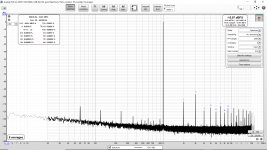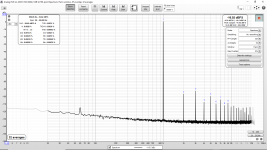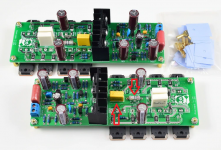Very nice placement and short/direct wiring. Are you using the D1047/B817 that came with the boards?
Did you do any THD measurements?
Did you do any THD measurements?
Thanks Kozard!
I used ONSEMI NJW0302G/NJW0281, they came with the boards. I also have boards with the KEC transistors but l was getting impatient at the time.
I have not made any THD measurements as of yet. I do not have the gear and it did not seem meaningful to invest in such previously since I could not even get my builds noiseless.
I used ONSEMI NJW0302G/NJW0281, they came with the boards. I also have boards with the KEC transistors but l was getting impatient at the time.
I have not made any THD measurements as of yet. I do not have the gear and it did not seem meaningful to invest in such previously since I could not even get my builds noiseless.
Here are a couple of other blameless boards,
Blameless PA
Blameless 50
Blameless 100
Blameless 150
Project 61
Blameless PA
Blameless 50
Blameless 100
Blameless 150
Project 61
Are you sure?
View attachment 975361
The ones with the connectors on the end of a (c) date of 2017
View attachment 975362
and the ones with the connectors in the middle of the board have a (c) date of 2018
did you ever get confirmation that the older dated boards (2017) are technically the newer ones?
i'm not entirely sure which are which now
i know @billyfish010 is saying that the 2017s are, but never saw any further confirmation
of if there are 'in between boards' what other identifiers can we use
i have a 2018 board with the speaker connections in the middle, and the power connections at the end, just hooked it all up and my power supply went 'poof' (yay)
Same here, with multiple diferent boards. I,'ve burnt two fine capacitance multipliers with LJM boards. Every product with "genuine panda logo" is just a pile of fake components. You simply don't have to analyse a power transistor that blows at 10 mA and 12V. It doesn't pass the simplest of tests: it blows even before you hook it to serious source of electricity. It isn't so dishonest to sell fakes but it is utterly dishonest to come among people and join friendly conversation to reasure people that only he doesn't sell fakes. Only his fakes are genuine. Utter garbage.😀... just hooked it all up and my power supply went 'poof' (yay)
Last edited:
Same here, with multiple diferent boards. I,'ve burnt two fine capacitance multipliers with LJM boards. Every product with "genuine panda logo" is just a pile of fake components. You simply don't have to analyse a power transistor that blows at 10 mA and 12V. It doesn't pass the simplest of tests: it blows even before you hook it to serious source of electricity. It isn't so dishonest to sell fakes but it is utterly dishonest to come among people and join friendly conversation to reasure people that only he doesn't sell fakes. Only his fakes are genuine. Utter garbage.😀
very frustrating, i'm about $250 in, with two blown power supplies (one DOA from china, the other for a reason unknown to me) and about to put another 100 in with a connex SMPS
at 350 i wish i just spent the 500 and got a vtv hypex 252 and moved on with my life, haha
Last edited:
One of my two L20 V7 blew one of the four B817 PNP outputs a couple weeks ago and I just got around to probing today. Something else is wrong too besides the one blackened (100 Ohm?) resistor. I will need to dig in more as quick probing on the back of the transistors has not yet revealed the remaining problem(s).
Sigh. Still have never had one of my genuine Toshiba outputs blow.
I thought the quad output pairs of the L20 and L20.5 would insulate me from the "fragile" outputs. I guess not.
Sigh. Still have never had one of my genuine Toshiba outputs blow.
I thought the quad output pairs of the L20 and L20.5 would insulate me from the "fragile" outputs. I guess not.
Last edited:
@datrumole
Don't let a dishonest seller of fake components to deprive you from this fine hobby. There are two fine projects here: Alpha Nirvana and SX/KX amplifiers designed by respected members of this community.
That would cost more but in the end you may build a fine amplifier that will serve you for decades.
Good luck
Don't let a dishonest seller of fake components to deprive you from this fine hobby. There are two fine projects here: Alpha Nirvana and SX/KX amplifiers designed by respected members of this community.
That would cost more but in the end you may build a fine amplifier that will serve you for decades.
Good luck
@kozard
l do indeed respect your preservance, but, really, is it worth? Just look at the square vawe response of any LJM board at 50Hz. Beside all these troubles with blown components LJM boards simply fall too short at low frequencies. Blameless? Give me a break.
Always a pleasure reading your posts.
l do indeed respect your preservance, but, really, is it worth? Just look at the square vawe response of any LJM board at 50Hz. Beside all these troubles with blown components LJM boards simply fall too short at low frequencies. Blameless? Give me a break.
Always a pleasure reading your posts.
Last edited:
Well now that I am finishing up my two uPC1342V mono-blocks I would like to repair the L20 and L20.5 and compare them against the L20 V7 and L20.5. (Compare for a month or two.)
After down selecting one or two of the designs will be retired.
Then the best of those will be compared against the QUAD405-2 and MX50x2.
After down selecting one or two of the designs will be retired.
Then the best of those will be compared against the QUAD405-2 and MX50x2.
Super clean build, thank you for showing how it should be done!No noise can be heard with headphones connected to the outputs
Are the twisted wires required for low noise? Does twisting produce any actual measurable (or audible) improvement?
The TTC004B looks like it would work, but KSC2690 is an excellent (and proven) replacement for 2SD669, and is readily available.
Also, Unisonic has actually taken up production of the Hitachi 649/669 transistors, but they can be hard to find. I ordered a bunch from Profusion last year: 2SD669AL-T60-T NPN 160V 1.5A | Profusion
Attached is the distortion measurement from the surviving L20 V7 setup as a monoblock at 64W. (V7 is CFP output like the L20.5)
It sounds very nice. I am listening to the left channel through the L20 V7 monoblock but the right channel is a uPC1342V monoblock since the outputs blew on the second L20 V7. I think the other L20 V7 can be fixed. After removing all output transistors it can "power up" so to speak with the normal output offset voltage that it had before. (With no outputs and obviously no load.)
Next I will try to fix one of the L20.5 and see how that measures. I sure hope I don't have problems with those SMD...
It sounds very nice. I am listening to the left channel through the L20 V7 monoblock but the right channel is a uPC1342V monoblock since the outputs blew on the second L20 V7. I think the other L20 V7 can be fixed. After removing all output transistors it can "power up" so to speak with the normal output offset voltage that it had before. (With no outputs and obviously no load.)
Next I will try to fix one of the L20.5 and see how that measures. I sure hope I don't have problems with those SMD...
Attachments
Last edited:
If you want great sound don't even try with SMPS. Amplifier modulates available current so your sound will depend on the quality of your power supply.very frustrating, i'm about $250 in, with two blown power supplies (one DOA from china, the other for a reason unknown to me) and about to put another 100 in with a connex SMPS
at 350 i wish i just spent the 500 and got a vtv hypex 252 and moved on with my life, haha
First make yourself a good old fashioned powerful power supply. Meanwhile, read and find an adequate amplifier, and perhaps even more important, good DAC and preamplifier.
Don't jump into conclusions based on gossip, read carefully. Many "positive reviews" of sound quality are simply exaggeration.
Beware of fake "Audio Precision" measurement results.
Otherwise you'll throw away yet another $250 for nothing. I've already spend a lot on this hobby and intend to spend even more. It's fun, that's all that counts.
Take care🙂
Thanks Kozard!
I used ONSEMI NJW0302G/NJW0281, they came with the boards. I also have boards with the KEC transistors but l was getting impatient at the time.
I have not made any THD measurements as of yet. I do not have the gear and it did not seem meaningful to invest in such previously since I could not even get my builds noiseless.
i see a lot of the l20.5 boards lately are coming with the NJW0302G/NJW0281 transistors, do you have a link to the seller you used?
@datrumole
Don't let a dishonest seller of fake components to deprive you from this fine hobby. There are two fine projects here: Alpha Nirvana and SX/KX amplifiers designed by respected members of this community.
That would cost more but in the end you may build a fine amplifier that will serve you for decades.
Good luck
yeah, was not aware of all these issues before i dove in. i've got 100 invested into the case, and now 150 in blown components: one psu DOA (my fault for not testing immediately on arrival, missed window to replace), the other psu from the same order was taken out by a bad l20.5, which one of two is working just fine. just probed the transistors on the bad board and pretty much are all dead, as is the smaller diodes on the power delivery side, and potentially some of the voltage regulators. since these things are only sold in pairs stuck putting in another order for two
If anyone has repaired blown outputs in an L20.5 please let me know your opinion regarding the question in this link (regarding using metal oxide resistors):
In A CFP Output Should These Resistors Be Metal Oxide Type?
In A CFP Output Should These Resistors Be Metal Oxide Type?
Well I have made progress with repairing my L20.5 using Toshiba 2SC5200 and 2SA1943.
I have attached the measurement result at 64W.
However with a dummy load attached the amplifier board whistles when testing it with a 1kHz sine. See more at this link:
Why Is This L20.5 Amplifier Whistling With A Dummy Load?
I don't think any component on this board should vibrate/whistle/hum during a test with a dummy load. I assumed that the 10 Ohm was a metal oxide based upon appearance. Any chance that it is a wire wound type?
Does anyone have any idea what might be going on? This is the amplifier which burned up on first power up last year without a signal. My guess is that the whistle noise is coming from near the 10 Ohm resistor and yellow film/safety capacitor as shown on the attached image.
I have attached the measurement result at 64W.
However with a dummy load attached the amplifier board whistles when testing it with a 1kHz sine. See more at this link:
Why Is This L20.5 Amplifier Whistling With A Dummy Load?
I don't think any component on this board should vibrate/whistle/hum during a test with a dummy load. I assumed that the 10 Ohm was a metal oxide based upon appearance. Any chance that it is a wire wound type?
Does anyone have any idea what might be going on? This is the amplifier which burned up on first power up last year without a signal. My guess is that the whistle noise is coming from near the 10 Ohm resistor and yellow film/safety capacitor as shown on the attached image.
Attachments
Have you tested the board for high frequency oscillations? Mine has oscillated at ridiculously high frequencies before I have increased the bias value. Oscillations at low bias values could be the reason for overheating of the 10Ohm resistor.
So far no sign of an oscillation. It appears to be vibration of the 0.1 Ohm 5W BPR resistors. (When I touch and squeeze those resistors the sound changes.)
What frequency were your oscillations?
I experimented with various bias levels however I am an unable to get the low THD numbers quoted for the L20.5.
The uPC1342V and the L20 V7 both measure lower THD.
What frequency were your oscillations?
I experimented with various bias levels however I am an unable to get the low THD numbers quoted for the L20.5.
The uPC1342V and the L20 V7 both measure lower THD.
Last edited:
1) 54MHz...
1.
What frequency were your oscillations?
2.
I experimented with various bias levels however I am an unable to get the low THD numbers quoted for the L20.5....
2) Impossible with Generic/Fake transistors.
Whatever you do THD remains at the same level, just oscillation disappears.
 🙄
🙄- Home
- Amplifiers
- Solid State
- L20.5 AP SYS Test data My design


